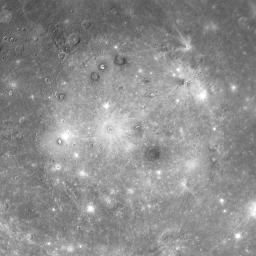This view is a mosaic of multiple MDIS images and shows the Caloris basin in its entirety. The Caloris basin was discovered in 1974 from Mariner 10 images, but when Mariner 10 flew by Mercury, only the eastern half of the basin was in daylight. During MESSENGER's first Mercury flyby, the spacecraft was able to acquire high-resolution images of the entire basin, revealing the full extent of this great basin for the first time.
Geologists use the term "basin" to refer to an impact crater that is larger than about 300 kilometers (186 miles) in diameter and often displays multiple concentric rings. Caloris has one main topographic ring (1550-kilometer diameter). Patterns of concentric structures both inside and outside the main ring have been mapped and interpreted as evidence for additional rings. Caloris is one of the largest impact basins in the Solar System, and MESSENGER's orbital observations will provide much more data for this impressive geologic feature, including high-resolution color and low-Sun images for discerning morphology. This mosaic was obtained when the Sun was high overhead. Such lighting conditions emphasize brightness differences among the surface materials, with little shadowing to provide a sense of the texture and topography. The interior of the basin has been filled with lighter-hued plains, which in turn have been modified by impact craters. The craters range from small bright dots to larger craters with bright rays. Some of the larger craters exhibit dark rims. The dark rims suggest that dark material underlies the interior plains in some places and was exposed through the formation of those impact craters.
Date Acquired: January 14, 2008
Instrument: Narrow Angle Camera (NAC) of the Mercury Dual Imaging System (MDIS)
Scale: Caloris basin is 1,550 kilometers in diameter (960 miles)
These images are from MESSENGER, a NASA Discovery mission to conduct the first orbital study of the innermost planet, Mercury. For information regarding the use of images, see the MESSENGER image use policy.

 Planetary Data System
Planetary Data System












